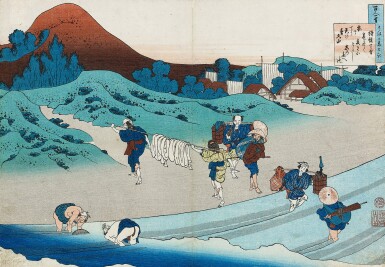Private Collection of Fine Japanese Prints
Private Collection of Fine Japanese Prints

KATSUSHIKA HOKUSAI (1760-1849) POEM BY JITO TENNO (EMPRESS JITO) | EDO PERIOD, 19TH CENTURY
Lot Closed
October 8, 01:23 PM GMT
Estimate
6,000 - 8,000 GBP
Lot Details
Description
KATSUSHIKA HOKUSAI (1760-1849)
EDO PERIOD, 19TH CENTURY
POEM BY JITO TENNO (EMPRESS JITO)
woodblock print, from the series The Hundred Poems [By the Hundred Poets] as Told by the Nurse (Hyakunin isshu uba ga etoki), signed saki no Hokusai manji, published by Nishimuraya Yohachi (Eijudo), censor's seal kiwame, circa 1835-36
Horizontal oban:
25.2 x 36.1 cm, 10 x 14¼ in.
To view Shipping Calculator, please click here
S. Nagata, Hokusai Museum (Hokusai Bijutsukan): Tales (Monogatari-e), vol. 5, 2nd ed. (Tokyo, 1990), pl. 130
Okayama Museum, Tokubetsu-ten Hiroshige to Hokusai Rokuju yoshu meishozu-e to Hyakunin isshu uba ge etoki (Sakai Collection), Okayama Museum, Okayama, 29 October - 23 November, exhib. cat (Okayama, 1983), pl. 2
W. Crothers, T. Kobayashi and J. Berndt, Hokusai, NGV International, Melbourne, 21 July- 15 October 2017, exhib. cat. (Melbourne, 2017) p. 169
Okayama Museum, Okayama, 29 October - 23 November 1983
Hokusai, National Gallery of Victoria International, Melbourne, 21 July - 15 October 2017
For his last single sheet series of woodblock prints, One Hundred Poems Explained by the Nurse (Hyakunin isshu uba ga etoki), Katshushika Hokusai looked to an anthology of well-known poems, entitled Hyakunin Isshu (A Hundred Poems by a Hundred Poets), as his source. These poems, based on love and melancholy, were assembled by the thirteenth-century poet Fujiawara no Teika. Hokusai chose to visually recount the poems from the perspective of a fictional elderly nurse. Together with sixty-four preparatory drawings, twenty-seven published prints are known, each exhibiting bold colour and including a cartouche enclosing the relevant verse. The series was commissioned by the publisher Nishimura Yohachi and his firm Eijudo successfully issued five prints before closing down; the additional twenty-two prints were then published by Iseya Sanjiro’s firm Iseri, with the original Eijudo seal continuing to be employed.
The poem in this print is by Empress Jito (645–702) and describes the activity of cleaning and drying textiles during the stormy summer season.
Haru sugite
natsu ki ni kerashi
shirotae no
i hosu tefu
ama no Kaguyama
Spring has passed
and summer, it seems, has come
garments of white cloth
are spread to dry
the clouds are cloaking
heavenly Mount Kagu
Two male figures, their legs half submerged in the river, lean over to wash bundles of cloth, while their female companions transport the wet cloth, wrapped around a pole, to the nearby village sheltered by Mount Kagu, from where three travellers have journeyed. It is in this village that the cloth is dried, hung from drying poles scattered among the houses.
For another impression in The Metropolitan Museum of Art, New York, see accession no. JP2550
